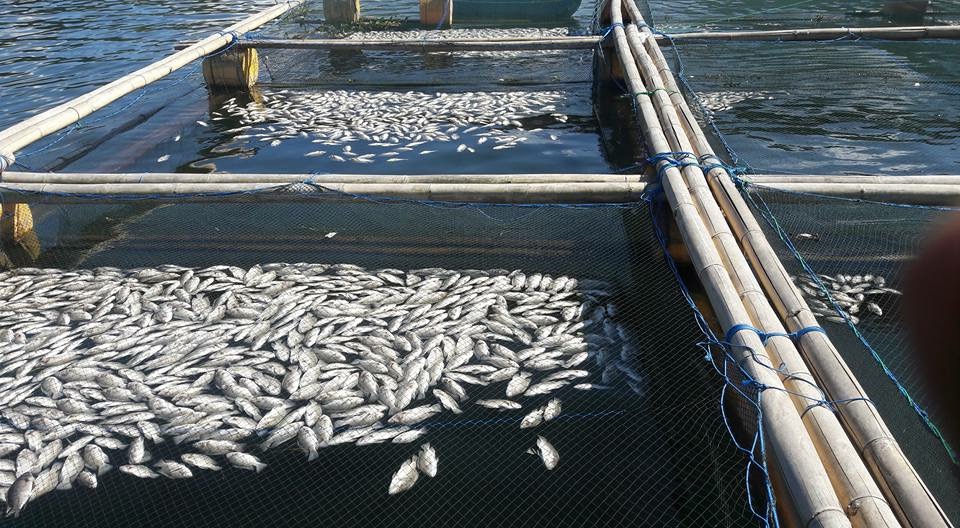- Mass fish die-offs are not uncommon in the volcanic lakes that dot Indonesia, including Bali’s Lake Batur, which sits in the crater of an active volcano.
- While sulfur releases, steep temperature gradients and other natural phenomena are responsible for some of the bigger die-offs, researchers have identified the chemicals from excess fish feed as the main culprit for the more frequent die-offs caused by oxygen depletion.
- Similar die-offs in other lakes around Indonesia have also been traced back to household and industrial waste, as well as agricultural runoff and fish farms. Researchers have warned that more than a dozen lakes could die out as soon as 2025 as a result of this chemical assault.
DENPASAR, Indonesia — Tilapia is a mainstay of Balinese cuisine, but hundreds of thousands of the freshwater fish choke to death regularly in the resort island’s largest lake, for reasons that researchers say are entirely preventable.
Mass fish die-offs are not uncommon in the lakes that dot the string of seismically active islands making up Indonesia, but tend to be the result of natural phenomena. In Lake Batur, a couple of hours drive east from Denpasar, Bali’s capital and biggest city, the sudden release of sulfur from the bottom of the crater lake last year led to the deaths of 15 tons of tilapia and cost local aquaculture farmers some 400 million rupiah ($29,000).
The first reported mass die-off at Batur, which sits in the caldera of an active volcano of the same name, was in June 2011, and left officials scooping up more than 3 tons of dead fish in just a couple of days. An investigation at the time concluded that the incident was caused by a steep temperature gradient between the air and the water, which generated waves that churned up the mud from the lakebed, killing the fish.
Now, however, researchers at Bali’s Udayana University have identified a human factor behind a string of regular die-offs at Batur. The modus operandi: A depletion of oxygen in the water near the surface of the lake. The culprit: Fish feed. Lots of fish feed.

The researchers discovered that the lake contained untenable levels of chemicals — nitrites, sulphides and sulphates — introduced into the water from fish feed. Concentrations of these chemicals were particularly high in fish farms and parts of the lake close to an agricultural waste dump and residential areas.
There are about 180 aquaculture operations dotted across Batur, with nearly 9,000 floating steel-framed cages between them, holding primarily Nile tilapia (Oreochromis niloticus). Fish pellets that go uneaten sink past the cage mesh and into the lake below, dissolving in the water.
To prevent further die-offs, the researchers recommended installing finer nets below the cages to catch these pellets. They also suggested stocking the cages with plants that would absorb the excess nutrients introduced by the fish feed.
“The farmers must start to manage their cages properly to reduce the risks,” said Gede Raka Angga Kartika, one of the researchers.

The incidents at Batur are hardly Indonesia’s only mass fish asphyxiations. Similar incidents have occurred at Lake Maninjau in Sumatra and in the reservoirs of western Java. One of the biggest recent die-offs linked to oxygen depletion took place in Lake Toba’s Haranggaol Bay, in North Sumatra. The blame there, as at Batur, was pinned on an excess of fish feed, as well as sewage and leached chemicals from detergents and fertilizers.
Water contamination from fish farms, household and industrial waste, and deforestation have put more than a dozen Indonesian lakes, including Batur, Toba and Maninjau, at risk of dying out, some as early as 2025, researchers warn.
Banner image: Recurring mass fish die-offs occur at Bali’s largest lake, Batur, because of chemicals introduced by fish feed that starve the water of oxygen. Photo by Suka Merta/Mongabay-Indonesia.
FEEDBACK: Use this form to send a message to the author of this post. If you want to post a public comment, you can do that at the bottom of the page.
